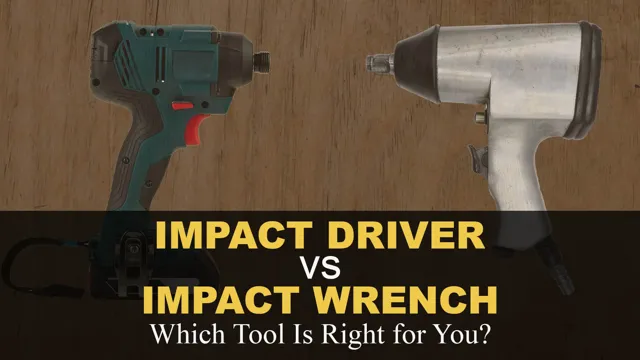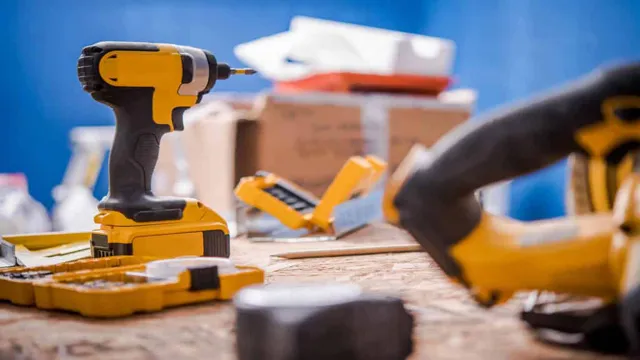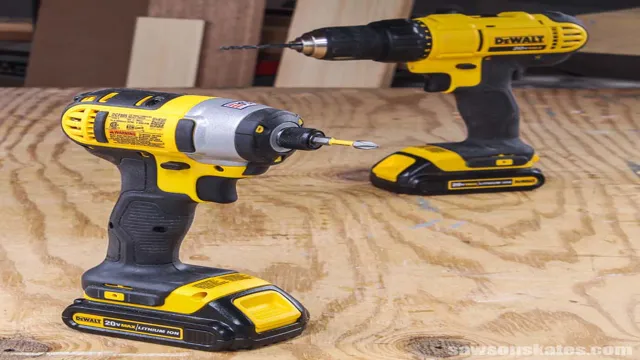Can I Drill with an Impact Driver? Tips, Tricks, and Safety Guidelines
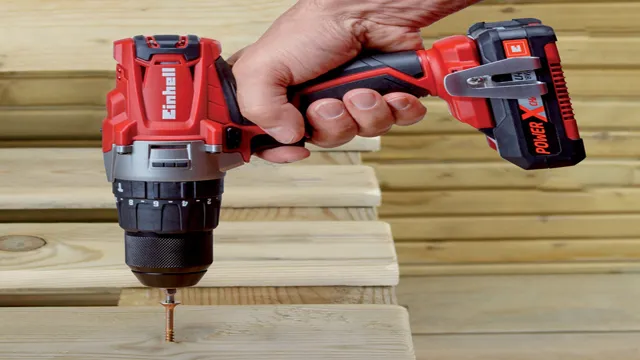
If you’re a DIY enthusiast or a professional contractor, you must have wondered at some point, “Can you drill with an impact driver?” The short answer is yes, you can! But it requires a bit of explanation. An impact driver is an essential power tool that’s primarily designed to drive screws and bolts with ease. However, with the right bit and technique, you can also use it to drill holes in different materials like wood, metal, and concrete.
But wait, how is an impact driver different from a drill? Well, a drill applies constant force and rotation to drill through materials, while an impact driver delivers high torque and sudden bursts of rotational force to drive screws and bolts more efficiently. This makes the impact driver ideal for jobs that require more power and speed, like fastening deck screws and building fences. However, if you need to make precise holes or bore large-diameter holes, a drill is still the better option.
That said, if you only have an impact driver at hand, you can still use it to drill small- to medium-sized holes, provided that you use the right bit and adjust the speed and pressure accordingly. For instance, if you need to drill into wood, use a spade bit or a twist bit and start at a low-speed setting. Apply moderate pressure and pull the trigger in short bursts to avoid overheating the motor or stripping the bit.
For metal, use a metal-cutting bit and go at a slower speed, using lubricant to reduce friction and wear. In conclusion, while an impact driver may not be the most versatile tool for drilling, it can still serve as a handy backup or complementary tool when you need to tackle some quick drilling tasks on the job site or at home. Just remember to always read the user’s manual, wear safety gear, and use the right bit for the material and task at hand.
Understanding Impact Drivers and Drills
Many DIY enthusiasts ask themselves, “Can I drill with an impact driver?” The answer is yes, you can! However, it’s important to understand the differences between impact drivers and drills to determine which one is the better tool for the job. Drills are ideal for making small holes in lightweight materials, while impact drivers are perfect for driving long screws and bolts into hard surfaces like concrete, brick, and dense wood. An impact driver’s internal mechanism creates torque that allows it to deliver a quick, repeated burst of power, which can cause damage or break bits if used incorrectly.
With its unique combination of speed and power, an impact driver can handle tough jobs with ease, making it an essential tool in any DIY enthusiast’s toolkit. However, for precision drilling, a drill is the best option. So, the answer is yes, you can use an impact driver to drill, but be aware of the differences and choose the right tool for each job.
Impact Drivers vs Drills
When it comes to DIY projects or professional projects, choosing the right tool for the job can make all the difference between a successful project and one that falls short. Two of the most commonly used power tools are drills and impact drivers. While at first glance they may seem like interchangeable tools, they each have their own unique advantages and uses.
Drills are great for drilling holes, tightening screws, and basic woodworking tasks. On the other hand, impact drivers are designed for tasks that require high torque, such as driving long screws or bolts into hardwoods or metals. Think of it this way: if you were trying to hammer a nail into a piece of wood, a drill would work, but it wouldn’t be the most efficient or effective tool.
An impact driver would be the better choice, providing the extra force needed to get the job done quickly and efficiently. When choosing between the two, consider the specific needs of your project to ensure you have the right tool for the task at hand.
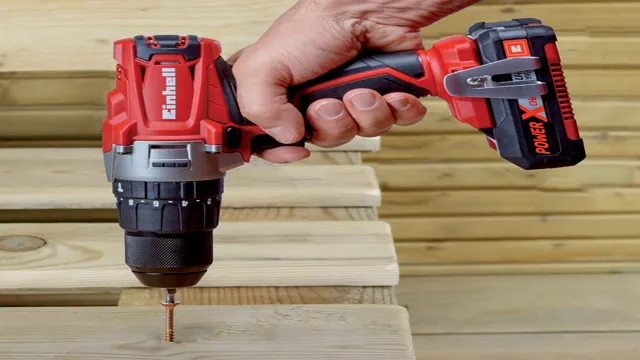
Features of Impact Drivers and Drills
Impact drivers and drills are tools commonly used in construction, woodworking, and automotive repair. While both tools look alike, there are a few key differences. Drills are designed primarily for drilling holes, while impact drivers are best for driving screws and bolts.
Impact drivers deliver much more torque than drills, making them more efficient for heavy-duty applications. Drills, on the other hand, typically have a clutch that allows the user to adjust the torque and prevent overdriving screws or damaging the material being drilled. Additionally, impact drivers have a hex-shaped chuck that accepts screwdriver bits, while drills generally have a three-jaw chuck that can hold a variety of drill bits.
Both tools have their unique features, and it’s essential to understand their differences before selecting the appropriate tool for the job.
Using an Impact Driver for Drilling
If you’ve ever wondered, “Can I drill with an impact driver?” The answer is yes! An impact driver is a versatile tool that can be used for tightening screws, loosening bolts, and with the right attachments – drilling holes. However, it’s important to note that impact drivers are not designed to replace traditional drills for heavy-duty drilling applications. Impact drivers excel at driving screws quickly and efficiently by delivering bursts of rotational torque to the fastener.
Unlike traditional drills, which rely on constant rotational power, impact drivers use concussive blows to drive screws and bolts. While impact drivers may not be the most precise tool for drilling holes, they can be effective for small holes in softer materials like wood or drywall. So, if you’re in a pinch and need to do some light drilling, your impact driver can certainly get the job done.
Just make sure to use the appropriate attachment and take your time to avoid damaging the tool or your workpiece.
Advantages of Using an Impact Driver for Drilling
Impact drivers have become increasingly popular among DIY enthusiasts and professionals alike, and for a good reason. They offer many advantages over traditional drilling tools, making them an excellent choice for all kinds of drilling tasks. First and foremost, impact drivers are highly efficient tools that can make drilling much more manageable and faster, thanks to their powerful torque and speed.
They are also more compact and lightweight than typical drills, which makes them easier to handle and control, particularly in tight spaces. Furthermore, impact drivers can provide greater accuracy and precision when drilling, as they allow users to apply greater force without the risk of damaging the material. In conclusion, if you’re looking for a reliable and efficient tool for your drilling needs, you can’t go wrong with an impact driver.
Steps to Follow When Drilling with an Impact Driver
Impact Driver for Drilling Using an impact driver for drilling is a quick and easy way to get your jobs done. However, knowing the right steps to follow can make all the difference in the results that you get. The first step is to use the correct bit type for the job.
Impact drivers are designed to work best with hexagonal-shaped bits. Make sure that the bit is seated properly in the chuck and that it is tightened securely. Next, set the speed of the drill and begin drilling slowly while applying pressure to the drill bit.
It’s important to keep the drill bit lubricated with oil or water to prevent overheating and to ensure a smooth drilling process. After drilling, make sure to clean the bit and store it in a safe place. With these simple steps, you can confidently use your impact driver for drilling and complete your tasks efficiently.
Safety Precautions When Using Impact Drivers for Drilling
Impact drivers are powerful tools that can make drilling tasks much quicker and easier. However, there are some important safety precautions that you should take when using these devices. The most important thing to remember is that impact drivers are incredibly powerful and can easily cause injury if not used correctly.
Make sure that you always wear appropriate safety gear, including eye and ear protection, gloves, and a dust mask. Additionally, always make sure that your workpiece is securely clamped in place before you begin drilling, as this will prevent it from moving or spinning unexpectedly. Finally, always use the correct drill bit for the job at hand, and make sure that it is properly inserted and tightened in the impact driver before you begin drilling.
With these simple steps, you can ensure that you stay safe while using an impact driver for drilling, and get great results every time.
Conclusion and Recommendations
In conclusion, if you want the job done right, it’s best to use the right tool for the job. While an impact driver may seem like a tempting option for drilling, it’s not the most efficient or effective tool for the job. To avoid frustration and achieve the best results, opt for a dedicated drill when drilling holes.
After all, as the old saying goes, you wouldn’t try to fix a leaky faucet with a hammer now, would you?”
When to Use an Impact Driver for Drilling
Impact Driver for Drilling If you’re wondering when to use an impact driver for drilling, the answer can vary depending on the task at hand. While impact drivers are primarily used for driving screws and fasteners quickly and efficiently, they can also be used for drilling smaller holes. Impact drivers have a high-torque output that can make drilling through materials like wood, drywall, or metal a breeze.
However, they’re not ideal for larger holes and harder materials like concrete or brick. For those tasks, a drill or hammer drill would be more appropriate. An impact driver can be a great addition to any DIY toolkit, providing versatility and speed in a variety of tasks.
Whether you’re a professional contractor or a DIY enthusiast, an impact driver can help you work smarter, not harder. So, next time you’re drilling smaller holes in materials like wood or drywall, consider using an impact driver for faster and more efficient results.
Best Impact Drivers for Drilling Tasks
Impact drivers are a handy tool for drilling tasks, and can be a great addition to any DIY enthusiast’s toolkit. While they are primarily designed for driving screws and bolts, they can also be used for drilling holes in a variety of materials. If you’re in the market for an impact driver for drilling, there are a few things to keep in mind.
Look for a model with a high torque rating, as this will ensure that it can handle tough materials like concrete and metal. You’ll also want to consider the size and weight of the tool, as well as the battery life, to ensure that it’s comfortable and practical to use. Some of the best impact drivers for drilling tasks include the DeWalt DCF887D2, the Makita XDT131, and the Milwaukee 2753-2
These models all offer high torque and great performance, making them ideal choices for drilling through a range of materials.
Final Thoughts
Many people wonder if they can drill with an impact driver. The short answer is yes, you can use an impact driver as a drill with the right bit. The main difference between an impact driver and a drill is the way they deliver power.
An impact driver delivers rotational force and a hammering action simultaneously, whereas a drill only rotates. This makes an impact driver ideal for driving screws and fasteners, but it can also handle light drilling tasks. However, if you need to drill through hard material or make large holes, it’s best to use a drill instead.
Always make sure you have the right type of bit for the job and be careful not to apply too much pressure as an impact driver can be more powerful than a drill and can cause damage. In summary, while an impact driver can be used for light drilling tasks, it’s always best to use the right tool for the specific job at hand.
FAQs
What is an impact driver used for?
An impact driver is primarily used for screwing and unscrewing tasks, but it can also be used for drilling tasks with the right bits.
Can I drill concrete with an impact driver?
Impact drivers are not recommended for drilling concrete, as they lack the power and speed required to make clean holes. It is better to use a hammer drill for such tasks.
What type of drill bit should I use with an impact driver?
It is recommended to use hex shank drill bits with an impact driver. These bits have a quick-change design that allows for easy attachment and removal.
Can I use an impact driver as a drill?
Yes, you can use an impact driver as a drill, but it is not as effective as a dedicated drill. Impact drivers lack the precision and speed required for drilling tasks.
How do I choose the right impact driver for my needs?
When choosing an impact driver, consider factors such as the torque, speed, weight, and battery life. Also, ensure that it has the right chuck size and chuck type for your bits.
How do I maintain my impact driver for optimal performance?
To maintain your impact driver’s optimal performance, clean it regularly and lubricate it with oil. Also, store it in a dry and cool place and avoid overcharging the battery.
Can I use an impact driver to remove stuck screws?
Yes, an impact driver is very effective at removing stuck screws, especially when used with impact-rated bits. It applies high torque and rotational force to break loose stubborn screws.
